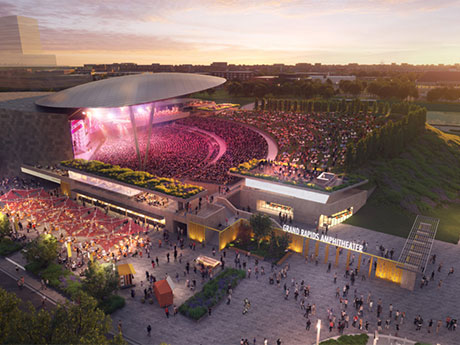By Scott Nurski and Kevin O’Reilly, NAI Wisinski Great Lakes
The Grand Rapids multifamily investment sales market has experienced reduced volume year-to-date, but the fundamentals remain strong. West Michigan, especially Grand Rapids, is affordable, with abundant high-paying employment opportunities and a high quality of life. In the words of author Malcolm Gladwell, “I love Grand Rapids. Why doesn’t everyone live in Grand Rapids?”
Unlike many major markets, the construction pipeline here is slow and steady, with little risk of oversupply. While multifamily sales volume is down across the board, Grand Rapids remains a desirable location for owners and operators alike.
Multifamily fundamentals
Annualized rent growth continues to normalize from the wild parabolic rise seen nationwide due to the pandemic and associated market disruptions. It currently stands at 5.1 percent, according to third-quarter data from CoStar for Kent County (30 units and above). This figure is a solid uptick from the second-quarter 2023 figure of 3.2 percent. The market generally is returning to the 3 to 5 percent range typically seen during pre-pandemic norms.

Occupancy improved slightly from 95.2 percent in the second quarter of 2023 to 95.4 percent in the third quarter of 2023. However, it has been gradually declining with the moderate increase in apartment deliveries, as third-quarter 2022 showed a figure of 96.2 percent, according to CoStar. Occupancy is anticipated to see minor declines, likely settling in the low 94 percent range by 2025, as new inventory may overtake marginal demand for a short period, according to CoStar.
According to Veronica Grecu of RentCafe, Grand Rapids emerged as the fifth-hottest rental market in the nation during the 2023 peak rental season. RentCafe analyzed 139 U.S. markets, where information was available, using five key metrics to rank the hottest renting spots during peak season. These include vacancy duration, occupancy rate, rental application competition, lease renewal rate and apartment completions. It is worth noting that this data only included developments of 50 units and larger. While it does not tell the whole story, it gives a sense of where Grand Rapids stacks up nationally.

One of the factors leading to these fundamentals for the Grand Rapids market is the limited supply of new units. The supply in Grand Rapids is slow and steady, with 1,720 units currently under construction and 1,802 units in lease-up across 12 new apartment communities. These supply figures are up slightly from last year when 1,194 units were under construction and 683 were in lease-up.
Current deliveries in the pipeline represent approximately 6.8 percent of total inventory. Absorption is trailing new supply to a minor degree, but leasing traction varies by submarket. Even as interest rates have climbed, the pipeline of proposed projects and new starts has remained fairly steady.
Anecdotally, developers are beginning to pause as the ever-rising cost of capital makes projects challenging to pencil out, despite construction costs for many components and trades normalizing or coming down considerably since the pandemic highs. Therefore, it is expected that new construction starts will diminish in the near term.
With that said, developers taking the long view on Grand Rapids are seeking well-located sites in anticipation of the capital markets moderating. Several recent housing studies have concluded there is a significant shortage of both for-sale and for-rent housing.
While this is consistent with nationwide supply and demand patterns, a study by the nonprofit HousingNext determined that the Grand Rapids area needs to add 35,000 housing units by 2027 to keep up with demand. Two years prior, this shortfall was calculated at 22,000 units required. Developers are paying attention to this data and are simply waiting for deal economics to improve in the next 12 to 24 months.
Asset pricing, sales volume
Much like national data trends, year-over-year investment sales activity for the Greater Grand Rapids area has diminished for the first three quarters of 2023 versus the same timeframe in 2022. This is not surprising, given the meteoric rise in interest rates. The market is still adjusting to the rapid rate increases, and investors are seeking more certainty, which has yet to occur. Total transactional volume is only down 23 percent, but activity has declined, reducing the number of transactions by almost 80 percent. Several large deals have propped up stats for 2023.
Even as borrowing rates steadily increased over the last 18 months, asset pricing remained resilient, with capitalization rates holding steady until mid-summer. While the active buyer pool has progressively shrunk with ever-rising capital costs, the number of buyers still significantly outnumbers sellers. This is due to a relative lack of inventory. Until recently, competitive bidding amongst buyers propped up pricing, particularly on value-add opportunities with significant proven upside.
Since midsummer, the bid/ask spread has recently become much more pronounced. Investors and lenders have become more deliberate and cautious in underwriting because there is less visibility on value. Lenders are heavily scrutinizing and stress-testing all aspects of the deal, including increasing expenses, such as property insurance and future property tax risk.
There are still many investors who are keen to look at deals. However, most buyers will not accept negative leverage on deal entry, even if current rents on an asset are substantially below market. Owners not under pressure or forced to sell are waiting until the capital markets improve. While there is inventory to trade, the bid/ask spread has slowed transactions, resulting in deals lingering or being pulled from the market.
Despite the challenging climate, it’s worth noting that sizable deals are still happening within the Greater Grand Rapids area. In March 2023, The Grove, a newly constructed, 320-unit, Class A asset completed in 2022 by Thompson Thrift, was sold to GSH Real Estate for $94.8 million, or $296,250 per unit.
In addition, the 924-unit portfolio of Woodland Creek and Woodbridge Apartments in Kentwood closed in the third quarter of 2023. The offering traded for $135 million, or $146,104 per unit (unweighted), to West Coast-based FPA Multifamily. These significant sales underline the continued desire for quality multifamily assets in the Greater Grand Rapids area.
Outlook
There are whispers of impending distress in the commercial real estate sector. However, due to the strong market fundamentals outlined, we foresee little distress in the Greater Grand Rapids multifamily market. Most owners have solid revenue and have secured low, in-place debt costs due to historically low interest rates.
It is pertinent to note that, even during the Global Financial Crisis, there was little foreclosure activity in the multifamily space. In particular, Grand Rapids experienced few multifamily notes called during that time. In today’s market, any distress will likely emanate from operator error or new construction projects without sufficient in-place capital streams. Given the attractiveness of the multifamily asset class, properties with health issues may recover via pent-up dry powder that is waiting on the sidelines to act as rescue capital for preferred equity stakes.
Powell and the Fed remain steady with an inflation target of 2 percent. As the Fed continues to curb inflation, the lagging impact of in-place measures remains to be seen. Any future interest rate hikes are likely to stifle investment sales activity further. The market craves stability, making uncertainty the greatest hindrance to loan activity and deal flow, rather than high interest rates alone.
While the buyer pool has shrunk in the past 12 months, institutional capital continues to target Grand Rapids. Why all the interest in a mid-sized Midwestern city? The area boasts a diverse economic base, including high-tech manufacturing and world-leading medical care and research.
Major new economic catalysts emerge with relative frequency, such as the new $100 million headquarters for Corewell Health (formerly Spectrum Health) in the North Monroe District of downtown. Arena South District projects include the $200 million mixed-use development, Studio Park, featuring a movie theater, event venue and the under-construction 16-story tower of 165 apartments and 24 condos. Nearby, the 12,000-seat riverside Acrisure Amphitheater is approved and ready to break ground.
Grand Rapids garners national attention and accolades for various attributes, including cost and quality of living, area amenities, employment and education opportunities. These factors have led to robust multifamily market fundamentals that stand out in national data analyses, attracting institutional investor attention.
Looking ahead, we are optimistic about a higher level of deal flow for the rest of the year and into 2024. Sophisticated buyers are still finding creative ways to transact. Investors continue to show interest in putting capital to work in this market. For these and many other reasons, the future is bright for Grand Rapids.
Scott Nurski is senior director of multifamily investment and Kevin O’Reilly is director of multifamily investment for NAI Wisinski Great Lakes. This article originally appeared in the November 2023 issue of Heartland Real Estate Business magazine.


